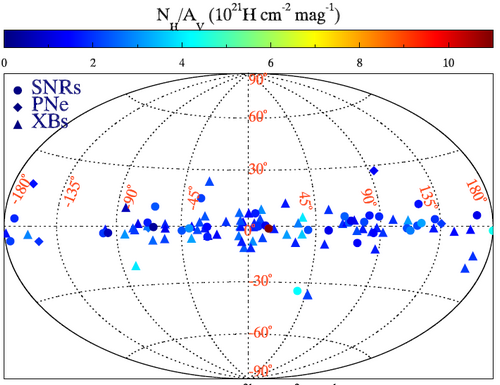The gas-to-extinction ratio (NH/Av), an essential parameter to study the structure of Milky Way, was obtained by researchers mainly in National Astronomical Observatories of Chinese Academy of Sciences (NAOC), with Dr. Zhu Hui as the lead author and Dr.Tian Wenwu, Dr. Li Aigen, and Zhang Mengfei as coauthors. Taking supernova remnants, planetary nebula and X-ray binary stars as the probes, they study the ratio of hydrogen column density estimated from X-ray absorption to optical V band extinction. They find this ratio almost does not vary with the spatial position and physical parameters of interstellar medium (ISM). Moreover, the average gas-to-dust mass ratio in Milky Way is 10%-30% higher than previous estimation. This work also yields other meaningful physical parameters, such as the scale height, the number density and the surface density of the Galactic gas. These new values will improve the researches on the Galactic structure, the dust model and the searching for the optical candidates of X-ray objects.
The universe is full of ISM. The light emitted by celestial objects will be absorbed and/or scattered before arriving at the earth, causing the observed brightness to be lower than the reality. This process is often referred as interstellar extinction, which is crucial for estimating the intrinsic brightness of celestial objects, studying ISM’s photoelectric heating rates and composition. At optical band, the extinction is mainly caused by the dust in ISM. It depends on the dust’s total mass, the composition and the size distribution. At X-ray band (>0.5 keV), the extinction is mostly from incompletely ionized heavy elements, such as O, Mg, Si and Fe. Thus, the optical extinction (described by Av at V band) can be used to trace the dust, while the X-ray absorption (described by NH) can probe the gas in atomic, molecular and ionized phases. The ratio of the two parameters can be used to constrain the composition of the ISM and the dust model.
At present, the commonly used ratio (NH/Av) was derived by Bohlin et al. at 1978. Based on the ultraviolet absorption of 75 stars with color excess less than 0.5 mag, they obtained a value of 1.87×1021cm-2mag-1H. However, they only take the atomic and molecular gas into consideration and ignore the contribution of ionized gas to total NH. By employing X-ray absorption, one can solve this problem and even extend the study to larger parameter space (the largest color excess could be 4.2 mag). For solar abundance and subsolar abundance, the NH to Av ratio based on X-ray absorptionare(2.08±0.02)×1021cm-2mag-1H and (2.47±0.04)××1021cm-2mag-1H respectively, remarkably larger than previous values.
This work has been published by MNRAS. More details: http://arxiv.org/abs/1706.07109.

Fig 1. The NH/Av ratiofor solar abundance. Black solid line and red dashed line show the different model fittings.

Fig 2. For solar abundance, the longitude-latitude projection of NH/Av in Milky Way.













